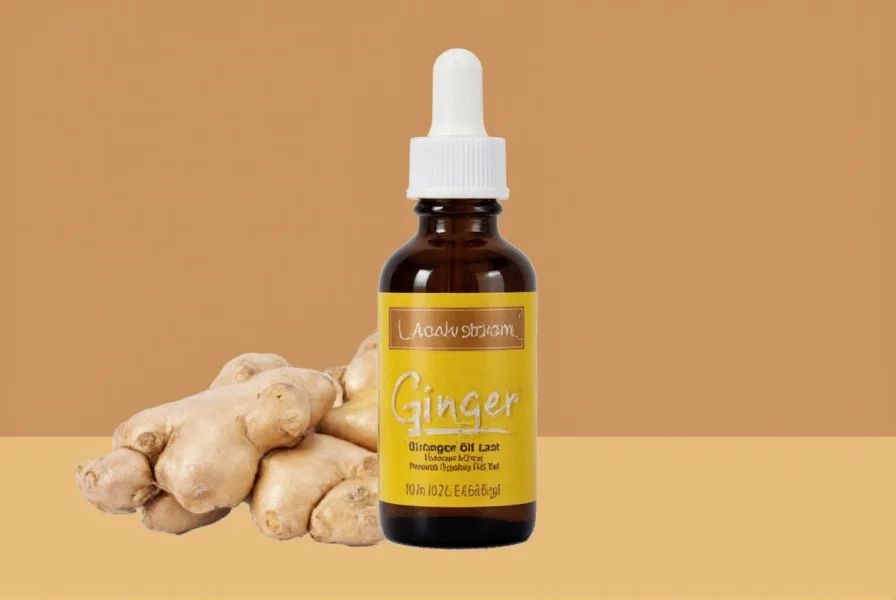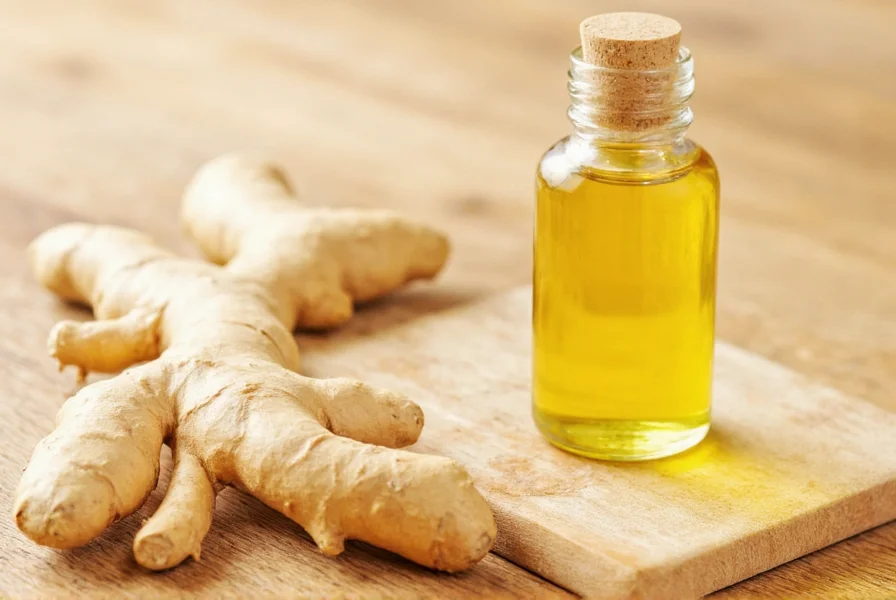Ginger essential oil, derived from Zingiber officinale rhizomes through steam distillation, offers a complex profile of chemical and therapeutic properties valued in aromatherapy and complementary wellness practices. This comprehensive analysis examines the scientific basis behind ginger oil's characteristics, separating evidence-based applications from anecdotal claims while providing practical usage guidance.
Chemical Composition of Ginger Essential Oil
The therapeutic potential of ginger oil stems from its diverse phytochemical profile. Unlike culinary ginger, the essential oil contains concentrated volatile compounds that provide its distinctive properties. Research identifies over 200 chemical constituents, with these primary components driving its characteristic effects:
| Primary Compound | Concentration Range | Associated Properties |
|---|---|---|
| Zingiberene | 20-35% | Anti-inflammatory, digestive support |
| Bisabolene | 10-25% | Skin soothing, anti-irritant |
| α-Farnesene | 5-15% | Antioxidant activity |
| Gingerols | 1-5% | Nausea relief, circulation support |
| Shogaols | Trace-3% | Enhanced bioavailability, warming effect |
These compounds work synergistically through what aromatherapists call the "entourage effect," where the combined action exceeds the sum of individual components' effects. The specific composition varies based on ginger variety, growing conditions, and extraction methods—factors consumers should consider when evaluating ginger oil quality.
Physical and Sensory Properties
Ginger essential oil demonstrates distinctive physical characteristics that aid in quality assessment:
- Color: Ranges from pale yellow to deep amber, with higher quality oils typically showing golden-yellow hues
- Viscosity: Thin consistency with density between 0.87-0.90 g/ml at 25°C
- Solubility: Insoluble in water but soluble in alcohol and carrier oils
- Aroma profile: Warm, spicy, slightly sweet with peppery undertones that evolve during evaporation
- Refractive index: 1.490-1.500, an important quality indicator for pure ginger oil
These physical properties serve as practical quality checkpoints. Significant deviations—such as unusually dark color or thick viscosity—may indicate adulteration or improper distillation. The characteristic aroma should be vibrant but not harsh; a burnt or overly sharp scent suggests overheating during extraction.

Therapeutic Properties Supported by Research
Scientific investigation has validated several therapeutic applications of ginger oil properties, distinguishing evidence-based uses from traditional claims:
Digestive Support Mechanisms
Ginger oil's most well-documented property is its effect on gastrointestinal function. Multiple studies demonstrate its ability to accelerate gastric emptying and reduce intestinal spasms. The active compounds interact with 5-HT3 receptors in the digestive tract, explaining its effectiveness for:
- Motion sickness relief (studies show 1-2% dilution in carrier oil applied to wrists)
- Post-operative nausea management
- Dyspepsia symptom reduction
- Travel-related gastrointestinal discomfort
Anti-Inflammatory Pathways
The anti-inflammatory properties of ginger oil operate through multiple biochemical pathways. Research published in the Journal of Agricultural and Food Chemistry demonstrates that gingerols inhibit COX-2 enzymes similarly to NSAIDs, but through different mechanisms. This explains ginger oil's effectiveness for:
- Muscle soreness relief when properly diluted (1-3% in carrier oil)
- Joint discomfort management
- Post-exercise recovery support
- Skin inflammation reduction
Safety Profile and Usage Guidelines
Understanding ginger oil safety properties is essential for responsible usage. While generally recognized as safe when used appropriately, specific considerations include:
- Dilution requirements: Maximum 2% concentration for adults (12 drops per ounce of carrier oil)
- Skin sensitivity: Always perform patch test; may cause irritation in sensitive individuals
- Contraindications: Avoid with blood-thinning medications; consult physician if pregnant
- Storage: Keep in amber glass bottles away from light; degrades after 1-2 years
- Ingestion: Not recommended without professional guidance
A 2022 safety review in Food and Chemical Toxicology confirmed ginger oil's low toxicity profile but emphasized proper dilution protocols. The study noted that undiluted application caused mild irritation in 15% of test subjects, while properly diluted applications showed no adverse effects.

Selecting Quality Ginger Oil
Given market variability, understanding how to evaluate ginger oil properties ensures you obtain authentic, effective product:
- Verify Zingiber officinale as the sole botanical name on labeling
- Check for GC/MS (gas chromatography/mass spectrometry) reports verifying composition
- Prefer oils labeled "steam distilled" rather than solvent-extracted
- Assess color—should be golden yellow, not dark brown
- Smell test—should have bright, spicy aroma without chemical notes
Reputable suppliers provide batch-specific information about origin and extraction methods. Ginger oil from India and China typically shows higher zingiberene content, while Nigerian varieties often contain more bisabolene—factors that influence specific therapeutic applications.
Practical Applications Based on Properties
Understanding ginger oil's chemical properties enables targeted usage:
- Digestive support: 1-2 drops in 1 tsp carrier oil massaged on abdomen
- Muscle recovery: 3% dilution in fractionated coconut oil for post-exercise massage
- Nausea relief: Diffuse 2-3 drops or apply diluted oil to wrists
- Circulation boost: 1% dilution in carrier oil for gentle massage on extremities
- Respiratory support: Add 2 drops to steam inhalation for sinus comfort
These applications leverage specific ginger oil properties while respecting safety parameters. The warming sensation associated with ginger oil comes from shogaols interacting with TRPV1 receptors—similar to capsaicin but milder—making it valuable for temporary comfort applications.
Conclusion
Ginger essential oil's properties create a unique therapeutic profile supported by growing scientific evidence. Its chemical composition—particularly gingerols, shogaols, and zingerone—drives its anti-inflammatory, digestive, and antioxidant effects. When properly sourced and used according to established safety guidelines, ginger oil offers versatile applications for wellness support. Understanding these properties enables informed usage that maximizes benefits while respecting individual sensitivities and contraindications.
Frequently Asked Questions
What are the main chemical properties of ginger essential oil?
Ginger essential oil's primary chemical properties include 20-35% zingiberene (providing anti-inflammatory effects), 10-25% bisabolene (skin soothing), 5-15% α-farnesene (antioxidant), and smaller amounts of gingerols and shogaols. These compounds create the oil's distinctive warm-spicy aroma and therapeutic profile, with density typically ranging from 0.87-0.90 g/ml and refractive index between 1.490-1.500.
How do ginger oil properties compare to fresh ginger?
While fresh ginger contains gingerols that convert to shogaols when dried or heated, ginger essential oil contains concentrated volatile compounds like zingiberene and bisabolene that aren't prominent in fresh ginger. The oil lacks the dietary fiber and water-soluble compounds found in fresh ginger but offers higher concentrations of certain therapeutic compounds. Essential oil provides faster absorption through skin or inhalation compared to oral consumption of fresh ginger.
What safety properties should I consider with ginger oil?
Ginger oil requires dilution to 1-2% maximum concentration for topical use due to potential skin irritation. It may interact with blood-thinning medications and should be avoided during pregnancy without medical consultation. Always perform a patch test before widespread use. Unlike some essential oils, ginger oil has low phototoxicity risk but should still be stored in dark glass containers away from light to preserve its chemical properties.
Which ginger oil properties make it effective for nausea relief?
Ginger oil's effectiveness for nausea relief stems from gingerols interacting with 5-HT3 receptors in the gastrointestinal tract and central nervous system. These compounds help regulate gastric motility and reduce vomiting signals. The oil's rapid absorption through inhalation or transdermal application provides faster relief than oral ginger consumption, making it particularly useful for motion sickness and post-operative nausea when used at 1-2% dilution.
How do ginger oil's anti-inflammatory properties work?
Ginger oil's anti-inflammatory properties operate through multiple pathways: gingerols inhibit COX-2 enzymes similar to NSAIDs but through different mechanisms, while zingiberene modulates inflammatory cytokines. The oil also contains compounds that suppress NF-kB activation, a key inflammation regulator. These combined actions make ginger oil effective for temporary relief of muscle soreness and joint discomfort when properly diluted (1-3% in carrier oil) and applied topically.











 浙公网安备
33010002000092号
浙公网安备
33010002000092号 浙B2-20120091-4
浙B2-20120091-4